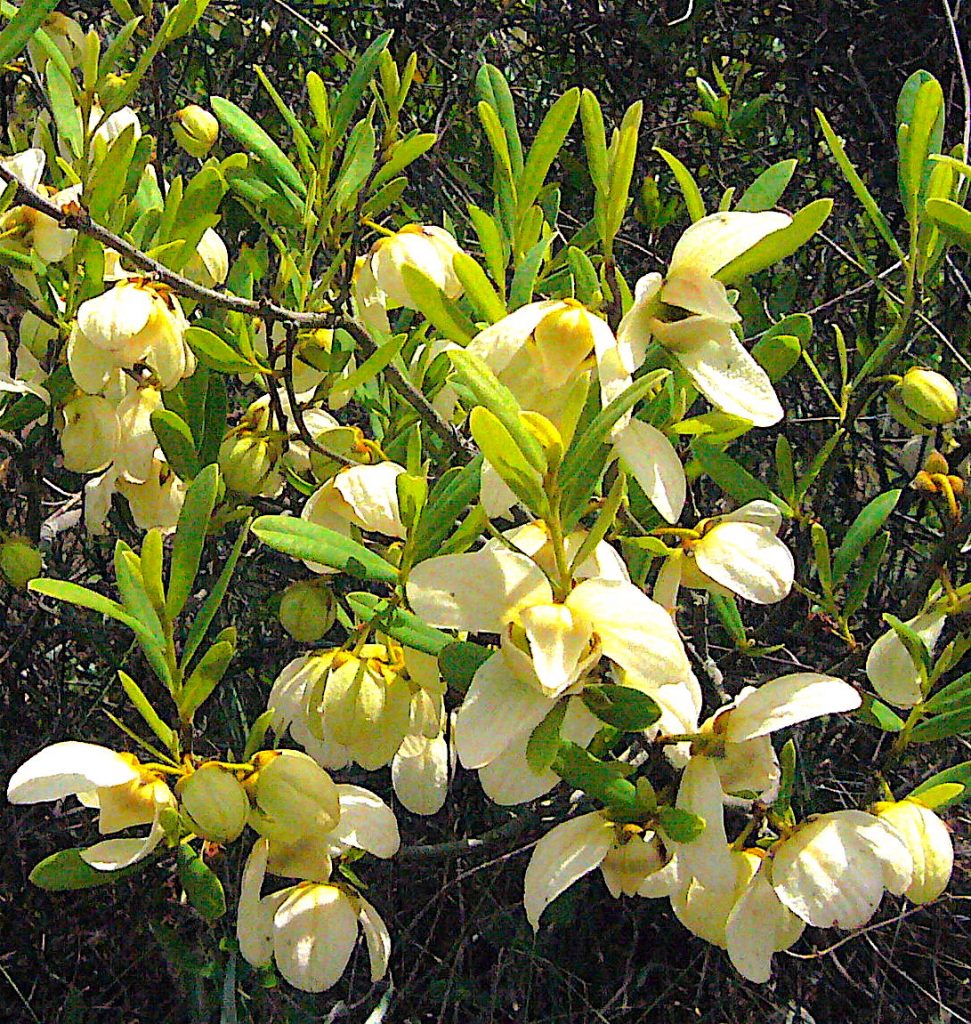
Pawpaws are blossoming. Photo by Green Deane
It’s a good time to identify Pawpaw by its blossoms. I see them regularly while driving local roads. Look for pastures along the byways, nice high and dry pastures. Pawpaws are one to two yard high with large cream-colored blossoms. Pastured livestock generally avoid the species. Finding the shrub is not the real challenge. Woodland creatures like the tasty ripe fruit so one has to find AND watch pawpaw to get some to eat.
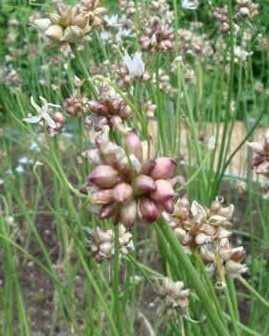
Wild Garlic will be cloving soon. Photo by Green Deane.
Getting ready to “fruit” is our wild garlic, Allium canadense. The plant is easy to find now in damp sunny areas and by next month will be putting garlic cloves on the top. Remember: if it looks like a garlic and smells like a garlic it is edible. The same holds true for onion, if it looks like an onion and smells like an onion it is edible. We dug some up during our foraging class in Gainesville last week. Their onion roots are small now as the energy in the root is being used to grow the plant and make cloves. What’s more important than their size is that you can transplant them and have a source of onions and garlic for flavoring without having to be reliant on stores. They often grow in profusion, becoming the dominant grass-like plant in a given area. The ornamental “Society Garlic” Tulbaghia violacea, is an edible distant relative of garlic. One can eat the leaves and blossoms, it rarely has a root worth preparing.
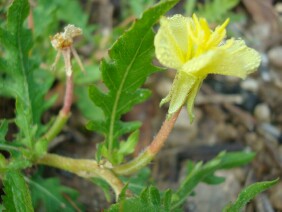
Oenothera laciniata, cutleaf evening primrose
There are two blossoms you might be seeing now. One is the non-edible vine Carolina jassamine (Gelsemium Sempervirens.) You will see it draping over fences and bushes. The other in the southern version of the Evening Primrose, generally considered not edible (but I haven’t proven that to myself.) The northern version of the Evening Primrose, Oenothera biennis, is called a “lost vegetable.” It was cultivated in Europe for about a century. There is a debate whether it is native to Europe or North America. Our Evening Primrose is O. laciniata, or the Cutleaf Evening-primrose. Unlike its northern sibling our local Evening Primrose does not grow tall, is a ground hugger, and is not considered edible. I have been meaning to try a little part of the blossom. A quarter of a century ago Forager Emeritus Dick Deuerling told me it was not edible. That said, Dick had texture sensitivities and said he only ate the “good stuff.” So he could have been saying he didn’t eat it. It’s a plant I’ve been meaning to explore. The natives ate several other Evening Primroses including O. albicaulis, O. biennis, O elata ssp. hookeri, and O. triloba. Another evening Primrose you might find in the northern part of the state is O. fruticosa. It’s not considered edible, either.
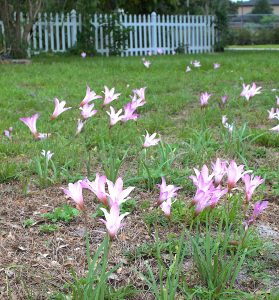
The Toxic Atamasco Lily
What are they? The first answer is they are NOT edible. The second is they are a threatened species. And the third answer is the toxic Atamasco lily, or Zephranthes atamasca . For a threatened species they are seen in a lot of lawns this time of year prompting many emails asking for an identification. These natives like wetlands though a well-watered lawn after seasonal rains will do nicely. The problem with the Atamasco/Rain Lily is that it resembles wild garlic before it blossoms (and even has a bulb!) However, it does not have the telltale garlic or onion aroma. Remember if it smells like a garlic and looks like a garlic you can use it like a garlic. The Atamasco does not have any garlic aroma. It is not edible. All parts are poisonous. And while these in the picture have a pink tinge there are also all-white blossoms.
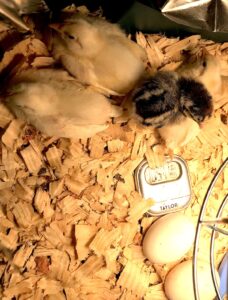
Two leghorns and a silver lace wyandotte.
Chicklettes: Unfortunately one died soon after relocation, the other three are doing well, having tried this week, chickweed, cucumber weed, purslane and apple. My home made incubator might add more babes this week. Chickweed, from the front yard, was quite popular (and why it was named that. Chicken, even baby ones, like it.) The apple core also received constant attention. These chicks are the leghorns, quite vocal and flighty, will lay white eggs. The deceased chick was replace with a very loud Silver Lace Wyandotte, not a breed I’m familiar with, lays brown eggs. My 15-year-old cat, Couscous, finds them … interesting.
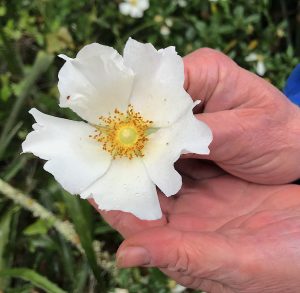
Cherokee rose is not native. Photo by Green Deane
An Asian species sighted this weekend is one that was once considered native, the Cherokee Rose, which is actually an invasive. Botanically Rosa laevigata (Rosa is from the Greek ῥόδον (rhódon) meaning rose and laevitata or (Levis) which is Dead Latin for smooth or polished. It’s a “climbing shrub” as is Smilax and Nicker Bean. Cherokee Rose is a large nearly odorless white bloomer from the low mountains of China and Vietnam. It was carried to the Americas in 1780 and was reportedly cultivated by the Cherokee thus the name. In 1916 at the urging of womens’ clubs it was made the state flower of Georgia and still is. It produces huge rose hips to two-inches long though you have to burn bristles off to use them. And as one might presume the rugged vining shrub is covered with mean prickles. Handle carefully. Sugar from the plant has been used to make wine.
Foraging Classes: March is something of a transition month for foragers, it might be the only month of spring here in Central Florida. It is a good month to identify plants that usually fruit in April, often our most productive month.Classes span both coasts this weekend, with a Saturday in Melbourne and Sunday Port Charlotte.
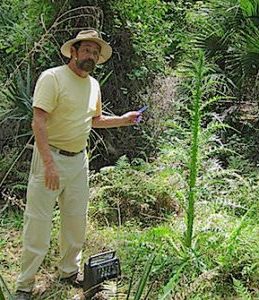
Foraging classes are held rain, shine, hot or cold. Photo by Nermina Krenata
Saturday March 18th, Wickham Park: 2500 Parkway Drive, Melbourne, FL. Meet at the “dog park” inside the park 9 a.m.
Sunday March 19th, Bayshore Live Oak Park Park, Bayshore Drive, Port Charlotte, Meet at the parking lot at Bayshore and Ganyard Street. 9 a.m.
Saturday March 25th, Mead Garden, 1500 S. Denning Dr., Winter Park, FL 32789. Meet at the bathrooms. 9 na.m.
Sunday March 26th, Eagle Lake Park, 1800 Keene Road, Largo, FL 33771. Meet at the pavilion near the dog park. 9 a.m.
Bring cash on the day of class or click here to pay for your class
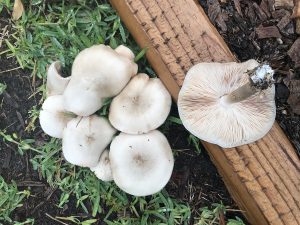
Deer Mushrooms like wood and cool weather. Photo by Green Deane
An edible mushroom that takes advantage of cool, rainy weather, such as this week, is the Deer Mushroom, in this case Pluteus petasatus. These are bunching mushrooms usually growing on old hardwood remains, either logs, stumps, roots or debris. As often is the case the botanical name is more confusing than enlightening. Pluteus can mean shed or penthouse. Petasatus is Dead Latin for wearing a cap (meaning) ready for a journey. A relative is called P. cervinus the latter means deer or stag because of that species’ cap color. It is also sometimes called the Deer Mushroom or Fawn Mushroom. These two are edible but are viewed as marginal. One reason is the cap is mostly gills with little cap material. Sometimes it can have a radish flavor. Spore print is salmon to pink.
My nine-DVD set of 135 videos has been phased out and replaced by 171-videos on a 128-GB USB, see right. The USB videos are the same videos I have on You Tube. Some people like to have their own copy especially if social order falters. The USB videos have to be copied to your computer to play. If you want to order the USB go to the DVD/USB order button on the top right of this page or click here. That will take you to an order form. Or you can make a $99 donation, which tells me it is for the USB (include a snail-mail address.) I’d like to thank all of you who ordered the DVD set over the years which required me to burn over 5,000 DVDs individually. I had to stop making them as few programs now will read the ISO files to copy them. Burning a set also took about three hours.

Green Deane Forum
Want to identify a plant? Perhaps you’re looking for a foraging reference? You might have a UFO, an Unidentified Flowering Object, you want identified. On the Green Deane Forum we — including Green Deane and others from around the world — chat about foraging all year. And it’s not just about warm-weather plants or just North American flora. Many nations share common weeds so there’s a lot to talk about. There’s also more than weeds. The reference section has information for foraging around the world. There are also articles on food preservation, and forgotten skills from making bows to fermenting food. Recent topics include: Stale Bread and Cod Liver Oil, Killing Bugs with Tobacco Plugs, Eating weeds: Is it safe? Have they mutated? Not the Eastern Red Bug but the Pink Tabebuia, African Tulip Tree, Asparagus densiflorus, Green Deane’s Book… You can join the forum by clicking on the button on the upper right hand side of this page.
This is my weekly newsletter #549. If you want to subscribe to this free newsletter you can find the sign-up form in the menu at the top of the page. My website, EatTheWeeds.com, which is data secure, has over 1500 plants on it in some 428 articles. I wrote every one myself, no cut and paste.
To donate to the Green Deane Newsletter click here.

